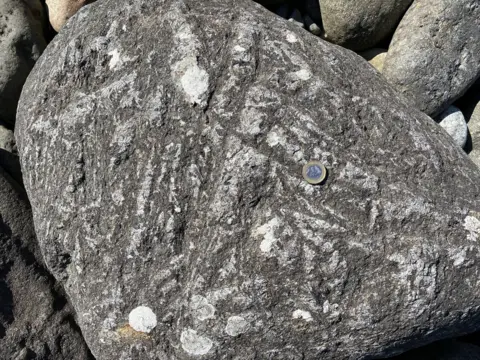Nasa collect Rum rocks ahead of Mars space mission
 Laurie Campbell/NatureScot
Laurie Campbell/NatureScotNasa scientists are collecting ancient rocks from the Isle of Rum because they are very similar to rocks on Mars.
The Rum rocks will be used to practise testing methods before a space mission returns with samples from the red planet.
Nasa's Perseverance Rover is collecting rocks from a crater on Mars which will be brought to Earth in 2033.
The Martian rocks could reveal clues about how the planet evolved, including the potential for past life.
Rum, off the west coast of Scotland, has been selected as the only UK site for sampling.
For the last week, scientists have been gathering rocks from the NatureScot National Nature Reserve (NNR) as part of the joint Nasa and European Space Agency's (ESA) Mars Sample Return Campaign.
Some of Rum's igneous rocks have a very similar mineral and chemical content to those found in the Séítah Formation within the Jezero crater on Mars.
Scientists will study them in order to understand what methods of testing and analysis will work best for when the Martian rocks are brought to Earth.
The Martian rocks will be the first samples brought to Earth from another world.
 Luke Daly/University of Glasgow
Luke Daly/University of GlasgowThe Rum sampling is being led by Dr Lydia Hallis, a geologist and planetary scientist from the School of Geographical and Earth Sciences at the University of Glasgow.
Dr Hallis, who is a member of the campaign's science group, said the Rum rocks were an "excellent comparison" to those in the Mars crater, as they were "characterised by the mineral olivine".
She added: "Not only is the mineralogy and chemistry similar, but the two rocks appear to have a similar amount of weathering.
"This seems strange when we think how wet and warm Rum is compared to present day Mars, but billions of years ago when the Séítah Formation crystallised on Mars the difference in environment would not have been so pronounced.
"At this time Mars was much wetter and warmer, with a thicker atmosphere that may even have produced rain - though not as much as we get in Scotland!"
She said that the Martian atmosphere thinned over time which left the surface much dryer and colder.
This stopped any further weathering within Séítah and preserved the rocks at Jezero Crater.
 NASA/JPL-Caltech
NASA/JPL-CaltechDr Hallis explained: "The rocks on Rum are younger geologically than those that have been collected on Mars by Perseverance.
"But their exposure to the Scottish elements has produced roughly the same amount of weathering as was produced in the Séítah Formation during Mars' early wet and warm climate.
"Because of all these similarities, analysis of the Rum rocks should give us a good head start and help the samples from the Red Planet achieve their full potential when they are returned to Earth."
Lesley Watt, NatureScot's Rum NNR reserve manager, said: "With its extinct volcanoes and dramatic mountains, Rum has always been one of the best places to discover Scotland's world-class geology, but we didn't quite realise that the rocks here were of interplanetary significance as well.
"It has been fascinating to learn more about the Nasa/ESA mission, and really exciting for the island to play a small part in this truly historic endeavour to find out more about Mars.
"We hope it will add yet another element of interest for visitors to this special place."
